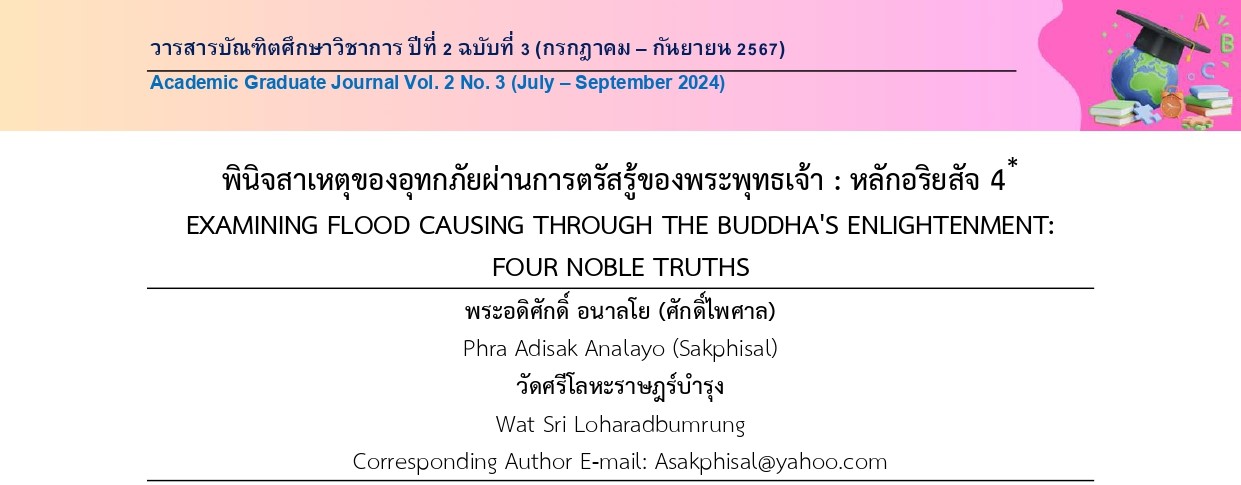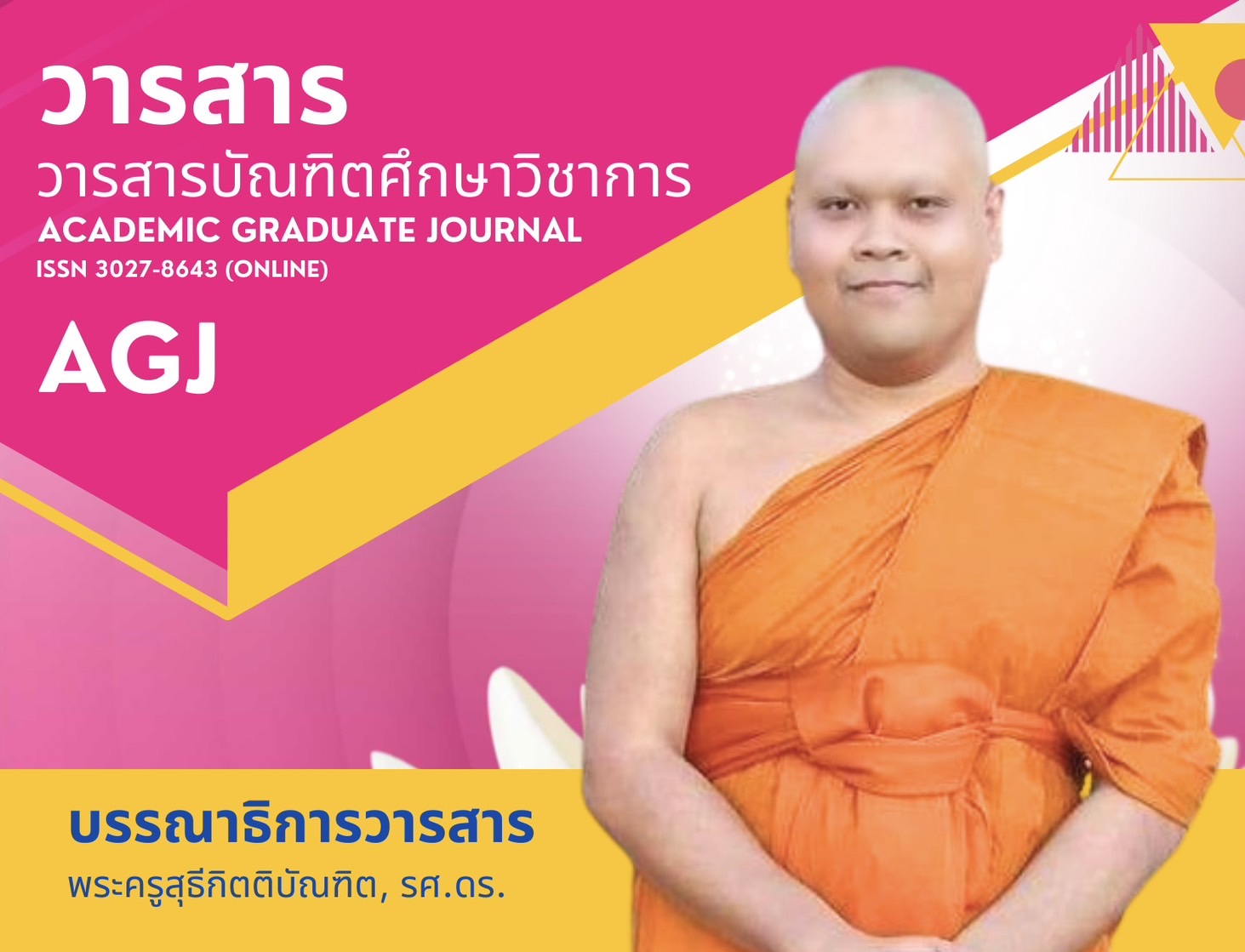EXAMINING FLOOD CAUSING THROUGH THE BUDDHA'S ENLIGHTENMENT: FOUR NOBLE TRUTHS
Keywords:
Flood Causing, Enlightenment, Lord Buddha, Four Noble TruthsAbstract
The article on examining the causes of floods through the Buddha's enlightenment: The Four Noble Truths is a study of documents, textbooks, and books, including synthesis. Analysis of the causes of flooding problems by reaching the true causes using the principles of the Four Noble Truths which is an important principle stated in the Abhidhamma Tipitaka. The main cause of floods stems from the increasing amount of rainfall. However, scientists have found that the rising temperature on Earth's surface is primarily due to the presence of greenhouse gases, particularly carbon dioxide. Carbon dioxide is a gas that controls the Earth's temperature. The amount of carbon dioxide affects climate change and global warming, leading to the melting of polar ice caps. This results in rising sea levels and contributes to atmospheric instability, resulting in suffering. The suffering caused by these disturbances is a consequence of things that disturb and provoke. These stimuli, which act as gas igniters, are called “samudaya,” the cause of suffering. The ability to lay down suffering until it is completely extinguished, which is called “nirodha,” is the cessation of suffering. To achieve the cessation of suffering, there must be a method known as “manga,” a path of understanding the Four Noble Truths that begins with oneself as the smallest unit of organization. By understanding one's feelings, analyzing the problem, and comprehending one's own emotions, individuals can face reality and proceed with efforts to solve problems correctly. Everyone can analyze problems and understand their feelings, encountering reality in a way that leads to the correct solution. The goal is to proceed with efforts to solve problems correctly.
References
เนชั่น สตอรี่. (2565). ปภ.อยุธยา ออกประกาศแจ้ง 6 อำเภอ เป็นพื้นที่ประสบภัยพิบัติ ให้ปชช.เตรียมรับมือ. Nation TV. สืบค้น 1 พฤษภาคม 2567, https://www.nationtv.tv/ news/social/378886720.
ประยูร เย็นใจ. (2563). การบริหารจัดการน้ำและการประเมินผลสัมฤทธิ์การใช้พื้นที่ลุ่มต่ำลุ่มน้ำเจ้าพระยา กรณีศึกษา : ทุ่งผักไห่ (พ.ศ. 2560). กรุงเทพฯ: เอกสารเผยแพร่ผลงาน กรมชลประทาน กระทรวงเกษตรและสหกรณ์.
มหาจุฬาลงกรณราชวิทยาลัย. (2539). พระไตรปิฎกภาษาไทย ฉบับมหาจุฬาลงกรณราชวิทยาลัย. กรุงเทพฯ: โรงพิมพ์มหาจุฬาลงกรณราชวิทยาลัย.
สำนักงานคณะกรรมการพัฒนาการเศรษฐกิจและสังคมแห่งชาติ สำนักนายกรัฐมนตรี. (2566). ตารางผลิตภัณฑ์ภาคและจังหวัด แบบปริมาณลูกโซ่ ฉบับ 2564. กรุงเทพฯ: สำนักนายกรัฐมนตรี.
Climate Central Organization. (2022). Climate Central Breakthrough Redraws Coastal Flood Maps. Retrieved May 1, 2024, from https://www.climatecentral.org/ climate-central-redraws-coastal-flood-maps, Access 26 December 2023.
Columbia University. (2010). Prime Minister of the Kingdom of Bhutan, Jigmi Y. Thinley at World Leaders Forum. Retrieved May 1, 2024, from https://www.youtube.com/watch?v=Ht9t7W-N_so.
Department of Economic and Social Affairs of United Nations Secretariat. (2010). World Youth Report: Youth and Climate Change. New York: The United Nations.
Graven, H.D. (2016). The Carbon Cycle in a Changing Climate. Physics Today, 69(11), 48-54.
Hooijer, A. & Vernimmen, R. (2021). Global LiDAR land elevation data reveal the greatest sea-level rise vulnerability in the tropics. Nature Communications, 12(1), 3592.
Intergovernmental Panel on Climate Change. (2023). AR6 Synthesis Report: Climate Change 2023. Research Report: The Panel’s 58th Session. Switzerland: IISD.
Jevrejeva, S., Jackson, L. P., Grinsted, A., Lincke, D., & Marzei, B. (2018). Flood damage costs under the sea level rise with warming if 1.5 ํC and 2 ํC. Environmental Research Letters, 13(7), 1-12.
Most Venerable Phra Brahmapundit, Editor. (2017). Common Buddhist Text: Guidance And Insight from The Buddha. Bangkok: Mahachulalongkornrajavidyalaya University Press.
Prime Minister’s Office, Singapore. (2019). National Day Rally 2019. Retrieved May 1, 2024, from YouTube. https://www.youtube.com/watch?v=bintmky4vca.







